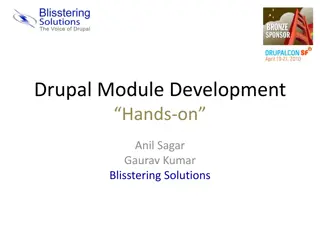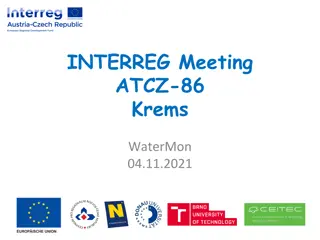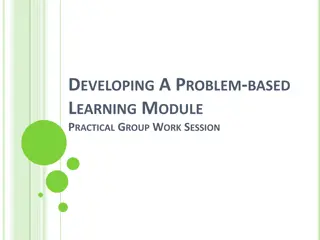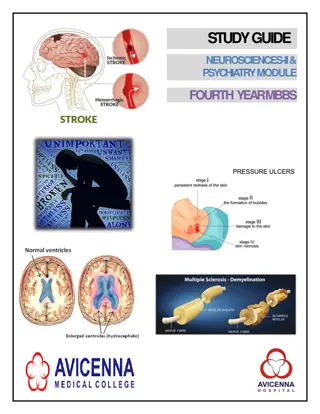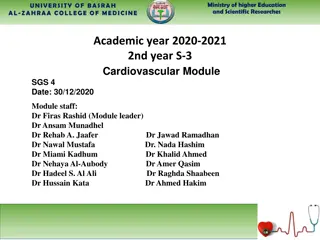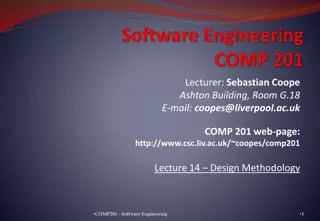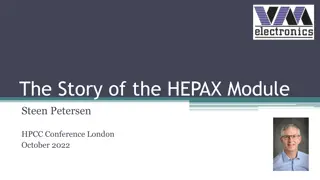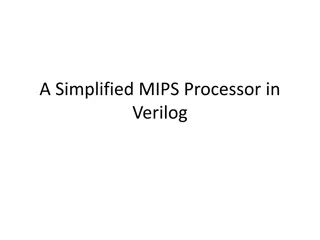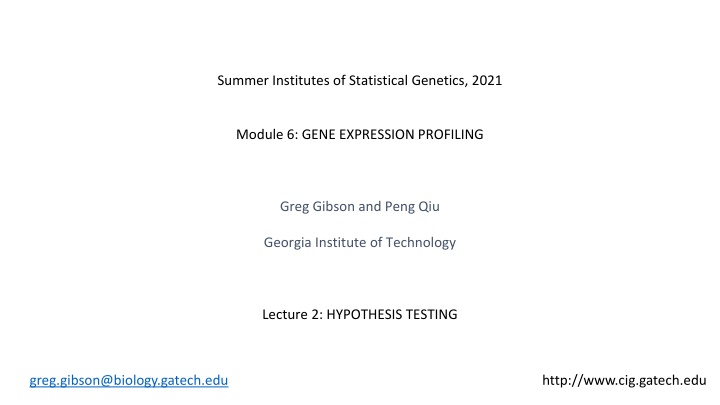
Gene Expression Profiling and Hypothesis Testing in Statistical Genetics
Explore the fundamentals of hypothesis testing in gene expression profiling, covering linear modeling, gene-level contrasts, t-tests, ANOVA, likelihood ratio tests, and more. Learn how to assess treatment effects and evaluate significance in genetic studies.
Download Presentation

Please find below an Image/Link to download the presentation.
The content on the website is provided AS IS for your information and personal use only. It may not be sold, licensed, or shared on other websites without obtaining consent from the author. If you encounter any issues during the download, it is possible that the publisher has removed the file from their server.
You are allowed to download the files provided on this website for personal or commercial use, subject to the condition that they are used lawfully. All files are the property of their respective owners.
The content on the website is provided AS IS for your information and personal use only. It may not be sold, licensed, or shared on other websites without obtaining consent from the author.
E N D
Presentation Transcript
Summer Institutes of Statistical Genetics, 2021 Module 6: GENE EXPRESSION PROFILING Greg Gibson and Peng Qiu Georgia Institute of Technology Lecture 2: HYPOTHESIS TESTING greg.gibson@biology.gatech.edu http://www.cig.gatech.edu
Fundamentals of Hypothesis Testing: Linear Modeling 1. Normalize the samples: log(fluorescence) = + Array + Residual log(CPM) = (read counts + 1) 106 / total read counts OR variance transforms, OR supervised methods 2. For each gene, assess significance of treatment effects on the Residual or the log(CPM) (ie. expression level) with a linear model: Expression = + Sex + Geno + Treat + Interact + Error OR likelihood ratio test or Wilcoxon Rank-Sum test, etc
Fundamentals of Hypothesis Testing: Gene-level Contrasts 1. Generally we are interested in asking whether there is a significant difference between two or more treatment group(s) on a gene-by-gene basis 2. For a simple contrast, we can use a t-test to test the hypothesis. Significance is always a function of: 1. The difference between the two groups: [4,5,6] vs [5,6,7] has a diff of 1 2. The variance within the groups: [2,5,8] vs [3,6,9] does as well, but is less obvious 3. The sample size: [4,4,5,5,6,6] vs [5,5,6,6,7,7] is better 3. For contrasts involving multiple effects, we usually use General Linear Models in the ANOVA framework (analysis of variance: significance is assessed as the F ratio of the between sample to residual sample variance. 4. edgeR uses limma to perform One-Way ANOVAs. This likelihood framework is very powerful, but constrains you to contrast pairs of treatments or sets of conditions with a reference 5. Robust statistics (eg using lme4) also allow you to evaluate INTERACTION EFFECTS, namely not just whether two treatments are individual significant, but also whether one depends on the other 6. Given a list of p-values and DE estimates, we need to evaluate a significance threshold, which is usually done using False Discovery Rate (FDR) criteria, either Benjamini-Hochberg or a qvalue
Fundamentals of Hypothesis Testing: t-tests and ANOVA A two-sample t-test evaluates whether the two population means differ from one another, given the pooled standard deviations of the sample and the number of observations: F-statistics generalize this approach by asking whether the deviations between samples samples are large relative to the deviations within samples. The larger the difference between the means, the larger the F-ratio, hence significance is evaluated by contrasting variances. Between Within Generally we start by evaluating whether there is variation among all the groups, and then test specific post-hoc contrasts. With multifactorial designs you also should be aware of the difference between Type I and Type III sums of squares, namely univariate and conditional tests.
Two other types of Hypothesis Test Likelihood Ratio-test { LR = -2 ln Model Comparisons Evaluates whether inclusion of a parameter explains the data better than not having it in the model -2ln(ratio) converges on 2 distribution with large n Gives you control over what contrasts to perform: Simplest model is the null Full models can include multiple parameters { (Likelihood of data with Parameter) (Likelihood of data with Simpler Model) Rank-Sum tests Non-parametric Does not assume anything about the distributions Tests for symmetry of ranks around the mean, but without caring about the actual deviations Wilcoxon Signed-Rank for paired samples Mann-Whitney U = Wilcoxon Rank-Sum for independent samples
Volcano Plots: Significance against Fold-Change The Significance Threshold at NLP = 5 (p<10-5) is conservatively Bonferroni corrected for 5,000 genes. While significance testing allows for inclusion of more genes that have small fold-changes (sector B), you need to be aware that there is also variation in the estimation of the denominator (variance) which can inflate NLP values.
FDR and qValues Traditional B-H False Discovery Rates simply evaluate the difference between the observed and expected number of positives at a given threshold, in order to estimate the proportion of false positives. Eg. In 10,000 tests, you expect 100 p-values < 0.01. If you observe 1000, then the FDR is 100/1000 = 10%. The q-value procedure estimates the proportion of true negatives from the distribution of p-values. https://www.bioconductor.org/packages/release/bioc/html/qvalue.html
Hypothesis Testing in edgeR If you compare the output of edgeR to those of a t-test or F-test, particularly for small n, you will often get very different results. There are at least 4 reasons for this. 1. edgeR performs a TMM normalization. Since RNASeq generates counts, we adjust for library size by computing cpm (counts per million). If a few high abundance transcripts vary by several percent, they throw off all the other estimates. TMM fixes this. 2. edgeR shrinks the variance of low abundance transcripts by fitting the distribution to the negative binomial expectation. Basically it adds values to account for sampling error at the low end so that comparing 0, 1 and 2 is more like comparing 10, 11 and 12. 3. edgeR also employs a powerful within-sample variance adjustment in its GLM fitting, with the result that it puts much more weight on fold-change than standard F-tests. 4. For a one-way ANOVA the approaches are similar (though you need to be careful about whether you fit an intercept, which means you compare multiple samples to a reference rather than to one another). For more complicated analyses involving two or more factors, nesting, and random effects, the modeling frameworks are really quite different. I prefer to run ProcGLM or ProcMIXED in SAS or JMP-Genomics; the equivalent in R is lme4, but needs looping of the code.
Type of Modeling I: Pairwise Contrasts FEMALE MALE LOW MODERATE HIGH
Type of Modeling II: One-Way ANOVA LOW FEMALE MOD FEMALE HIGH FEMALE LOW MALE HIGH MALE MOD MALE
Type of Modeling III: Post-Hoc Contrasts LOW+MOD FEMALE HIGH MALE
Type of Modeling IV: 2-Way ANOVA with Interactions FEMALE MALE LOW MODERATE HIGH
variancePartition Hoffman and Schadt (2016) BMC Bioinformatics 17: 483









